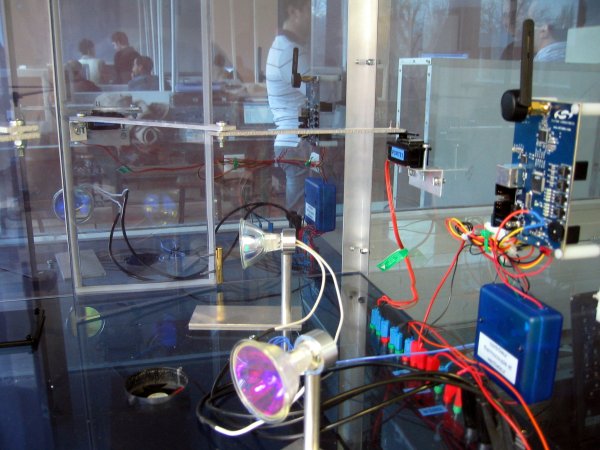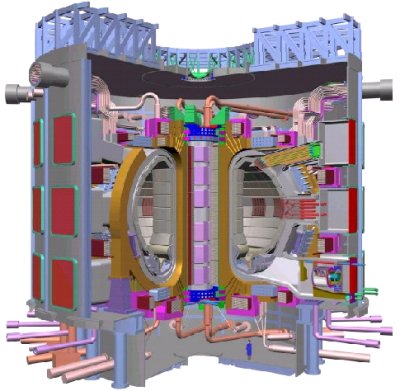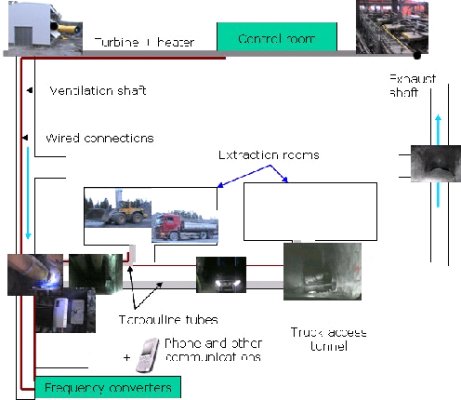WITRANT
Emmanuel
Professor UGA
Research:
Modeling and control of non-homogeneous transport phenomena



One of the major difficulties in the analysis of physics associated with transport phenomena in nonhomogeneous media is the complexity of the process model. This complexity is mainly due to the large-scale aspect, the medium heterogeneity and the dynamics of the interconnections (equilibrium, flow exchange, transport and propagation between the nodes). The approach considered in this project is based on the use of systems and control analytical framework to deal with complex physical models. Such models come from hydrodynamics (i.e. transport in porous media), aerodynamics (i.e. cryogenics) or magnetohydrodynamics (i.e. thermonuclear fusion) and are described thanks to partial or functional differential equations. Their use in control strategies imply to take into account the fact that the infinite dimensional aspect of the system (physical continuum) has to be discretized into a finite number of interconnected differential equations. In terms of control specifications, these research interests are characterized by:
- Interconnected system,
- Time-varying dynamics with nonlinear components,
- Distributed sensor/actuators,
- Complexity due to the systems size (large-scale) and different time scales,
- Constrained control.
Large scale instruments
Controlled thermonuclear fusion
Controlled thermonuclear fusion is a topic of prime interest as a source of sustainable energy, which could possibly compete with classical fission reactors in terms of efficiency and as a key process to produce energy. In the forthcoming years, the main challenge for the fusion community will be to develop experimental scenarios for ITER (" International Thermonuclear Experimental Reactor ", the largest fusion process ever built and with a first run planned for 2018). Amongst the key issues, the main control challenges are related to the plasma shape control, advanced equilibrium profiles for Tokamaks and the stabilization of magnetohydrodynamic (MHD) modes. Shape control has been studied extensively but many results still have to be discovered on the other two topics, where the nonhomogeneous transport of waves, energy and particles appear as a crucial issue.Collaborations: Alfven Laboratory (KTH, Stockholm), IRFM (CEA-Cadarache, France), JET (Culham, UK), MMAE at IIT (Chicago, USA).
Particle accelerators and detectors
The GIPSA-lab contribution is focused on the Large Hadron Collider (LHC, CERN, Geneva, Switzerland), and more precisely related to the cryogenics control in a large-scale instrument. The problem of efficient magnets cooling can be formulated as controlling the energy transport in long pipelines with distributed disturbances and boundary control. The process model implies to take into account complex fluid dynamics and heat exchanges, that are difficult to include in model-based control strategies with real-time and robustness constraints. Our contribution is to propose a control-oriented modeling approach, highlighting the fact that the fundamental physical properties of the non-homogeneous medium can be efficiently modeled with a local averaging (transmitted wave fading) of the energy distributions.Collaboration: CERN (Geneva, Switzerland).
Transport in air flows
Mining and intelligent buildings ventilation control
Real-time regulation of mining and building ventilation is a recent research area, where control strategies aiming at the global energy minimization are rapidly expanding. Actual automation processes are mainly manual or operated on a daily basis, most of the efforts being focused on the air paths design. This basic level of operation motivates further investigation, based on the analytical tools provided by the automatic control area of research. New control solutions involve the use of distributed sensors, wireless networks architecture, compressible fluid flows modeling, and, from a more general point of view, a control architecture that takes into account interconnected subsystems with complex dynamics.Collaborations: ABB, Boliden, KTH, University of L'Aquila, University of Sienna, LSS-Supélec, University of Craiova.
Poromechanics and chemical transport in firns
Trace gas measurements in interstitial air from polar firn allow to reconstruct their atmospheric concentration time trends over the last 50 to 100 years. This provides a unique way to reconstruct the recent anthropogenic impact on atmospheric composition. In polar regions where no melting occurs, snow transforms into ice through the effect of its own weight. The transition between an open-porosity material (snow/firn) into an airtight material (ice) then occurs at about 50-100 meters depth. Converting depth- concentration profiles in firn into atmospheric concentration histories requires models of trace gas transport in firn. A fundamental parameter of these models is firn diffusivity. We propose a new method to model non-homogeneous transport and evaluate the diffusivity of polar firns using automatic control analysis techniques.Collaboration: LGGE (Grenoble, France).
Flows and combustion control in car engines
Modern automobile engines must fulfill challenging conditions of efficiency and pollutant emissions, while satisfying stringent performance criteria. The development of new combustion modes and the inclusion of mechanical devices such as turbochargers, VVT (Variable Valve Timing) and exhaust gas recirculation (EGR) systems have helped to achieve those goals. These new developments improved dramatically engines performance, but also resulted in a less predictable combustion and flow circulation, which might alter the proper functionality of the exhaust-treatment systems. Studies on this area have concluded that in order to maintain the performance objectives, a more accurate model-based prediction of the combustion phenomena modeling is necessary. Furthermore, dual-loop exhaust gas recirculation with both high-pressure and low-pressure recirculation is one of the new strategies to achieve the appropriate conditions to implement multiple combustion modes. The aim of this research is thus to develop control-oriented models and feedback control laws for engines combustion and internal flows transport optimization.Collaboration: Modélisation DIM/DCMAP, Renault, Institut PRISME , Université d'Orléans.
Network controlled systems
The Network Controlled Systems (NCS) constitute a new subject of special interest in the field of control, in particular because of the communication channel between the system and the control law. This channel, often neglected, induces a modification of the signal that must be taken into account for the control of systems with fast dynamics or requiring a high level of performances. Our works in this line of research are based on a specific predictive architecture that compensate for the time-varying delay effects. The problems of stabilization, jitter compensation, robustness of the control design with respect to the delay estimation and optimal control design using Gauss-Newton analysis were considered. Both the linear and nonlinear cases are investigated.Collaborations: SOCRADES, HYCON, NeCS, NACO2.
Grenoble Images Parole Signal Automatique laboratoire
UMR 5216 CNRS - Grenoble INP - Université Joseph Fourier - Université Stendhal